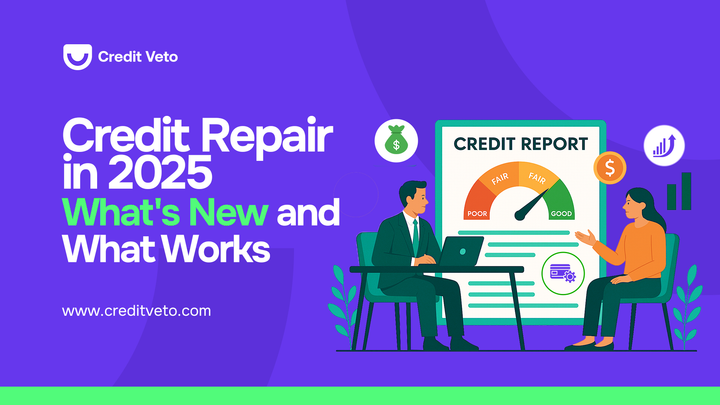What to Expect from a Credit Repair Challenge: A Step-by-Step Guide
Wondering what to expect from a credit repair challenge? Get a step-by-step guide to fix your credit or start a business with actionable insights and real tools.

Are you thinking about joining a credit repair challenge but wondering what to expect? Whether you’re looking to fix your own credit or start a new credit repair business, participating in a challenge can be one of the quickest ways to see real results.
But before you dive in, it’s important to know what the process looks like. Knowing what to expect will help you get the most out of the experience and avoid common mistakes that can derail your progress.
In this blog post, we’ll break down exactly what happens during a typical credit repair challenge, what you’ll learn, and how you can prepare for success.
Understanding the Credit Repair Challenge Journey
Before you jump into any credit repair challenge, it’s important to understand that this isn’t just about fixing credit, it’s about empowerment, growth, and building new habits. Even if you’re looking to repair your personal credit or explore a new business opportunity, a credit repair challenge offers a structured path toward achieving your goals.
In this step-by-step guide, we’ll break down exactly what you can expect from joining a challenge. From the moment you sign up to your progress after completion, each phase is designed to help you not only repair your credit but also master the skills needed to continue improving it for the long term.
Now, let’s dive into what this journey looks like.
Step 1: Set Clear Goals
The first step in any credit repair challenge is understanding your goals. Are you joining to repair your personal credit? Or are you looking to start a credit repair business and help others improve their credit scores?
When you sign up, you’ll be asked to outline your specific goals. This will help you stay focused and track your progress throughout the challenge. Whether you’re aiming to boost your credit score or launch your own business, having a clear goal from the start will keep you motivated and help you get the most out of the experience.
Step 2: Understand the Basics of Credit Repair
One of the first things you’ll dive into during a credit repair challenge is the foundational knowledge behind credit repair. If you’re feeling overwhelmed because you don’t know much about credit repair yet, don’t worry. This step is specifically designed for beginners, and you’ll be guided through the entire process in a simple, digestible way.
The goal of this step is to help you build a strong understanding of how credit works and what affects your score, so you can make informed decisions moving forward. Here’s what you can expect to learn:
How Credit Scores Work and What Affects Them
Your credit score is one of the most important numbers in your financial life. It determines your eligibility for loans, credit cards, and even jobs in some cases. But how is it calculated?
You’ll learn about the five major factors that influence your credit score:
- Payment History (35%): This is the most significant factor, showing whether you’ve made your payments on time.
- Credit Utilization (30%): The ratio of your current debt to your total available credit. Lower utilization is better.
- Length of Credit History (15%): The longer your credit history, the better it looks.
- Credit Mix (10%): A healthy mix of credit cards, mortgages, and installment loans can help.
- New Credit (10%): Opening too many accounts in a short time can negatively affect your score.
By the end of this part, you’ll understand exactly what moves the needle in terms of improving your credit and which areas to focus on for the fastest results.
Common Credit Report Errors That Can Be Disputed
Not all negative marks on your credit report are accurate. Mistakes happen all the time, and many people find errors that affect their score when they review their credit report. In this part of the challenge, you’ll learn how to spot the most common types of errors that can be disputed, including:
- Incorrect Account Information: For example, accounts that aren’t yours, wrong dates, or accounts reported as open when they’ve been closed.
- Late Payments: Sometimes, payments are marked as late when they weren’t or were incorrectly reported.
- Outdated Information: Negative items, like missed payments, can remain on your credit report longer than legally allowed.
- Duplicate Accounts: Sometimes, accounts can appear more than once, which can lower your score.
You’ll also be shown how to file disputes with credit bureaus and creditors to get these errors corrected, which could lead to an immediate improvement in your credit score.
The Laws Governing Credit Repair: FCRA & FDCPA
Credit repair isn’t just about sending letters or disputing items—it’s also about understanding the legal framework that protects you. In this step, you’ll get familiar with two critical laws that govern credit repair and debt collection:
- Fair Credit Reporting Act (FCRA): This federal law ensures that credit bureaus provide accurate, up-to-date information in your credit reports. You’ll learn how to use the FCRA to challenge inaccurate information on your report.
- Fair Debt Collection Practices Act (FDCPA): The FDCPA prevents debt collectors from using harassing or unethical practices to collect debts. You’ll discover how to recognize violations and protect yourself legally.
Understanding these laws will help you stay within the bounds of the law while disputing errors and fighting for your rights. It will also give you the knowledge to help your clients if you’re running a credit repair business so that everything is done legally and ethically.
Step 3: Learn How to Dispute Errors on Your Credit Report
One of the most important parts of the credit repair challenge is learning how to dispute errors on your credit report. This is where the magic happens because it’s the step that can lead to visible, measurable improvements in your score. It’s also the skill that can lay the foundation for a full-fledged credit repair business if you decide to help others too.
During the challenge, you’ll be guided step-by-step on how to review your credit report with a trained eye. You’ll learn how to spot inaccurate, unverifiable, or outdated negative items—things like late payments that were actually on time, old collection accounts that should have fallen off, or even accounts that don’t belong to you at all.
Once you know what to look for, you’ll be introduced to tools like Credit Veto Pro, which help automate the process. Instead of stressing over how to write a dispute letter or what to say, you’ll be able to generate letters automatically, using proven templates tailored to the type of error you’re addressing. The platform helps you save time, reduce mistakes, and move through the process confidently, even if you’re brand new.
You’ll also be taught the right way to submit disputes; because it’s not just about sending letters, but about knowing where to send them, how to document them, and what to expect in terms of timelines and follow-ups. You’ll learn the difference between disputing directly with credit bureaus vs. creditors, how to track responses, and how to handle pushback.
This step is more than just a task, it’s a skillset. One that puts you in control of your financial future and gives you a valuable service to offer others, should you choose to monetize what you’ve learned.
By the end of this phase, you’ll not only be able to clean up your own credit—you’ll also understand how to repeat the process ethically and effectively for clients, friends, or family.
Step 4: Build Credit, Not Just Repair It
While fixing credit report errors is essential, credit repair is also about building credit for the future. You’ll learn how to:
- Use credit responsibly to improve your score over time.
- Set up automated tools and systems to monitor your credit, ensuring you catch issues early.
- Understand the importance of credit utilization, on-time payments, and credit limits.
This step prepares you not only to fix your credit but to maintain a strong credit profile moving forward.
See also: Rebuild Your Credit From Scratch: The Credit Repair Guide They Don’t Teach You
Step 5: Scale Up, Turning Credit Repair Into a Business
For those who want to go beyond just fixing their credit, this part of the challenge is where things get exciting. If you’ve ever thought about launching a side hustle, creating a second income stream, or becoming your own boss, this step will show you how to start a credit repair business, even if you have no prior experience.
You’ll learn how to turn your new skillset into a real service that others will pay for, especially with so many people struggling with credit issues and looking for help they can trust.
Here’s what you’ll walk away with:
- How to offer credit repair as a paid service You’ll learn how to package your credit repair knowledge into a simple offer clients can understand. This includes setting pricing, understanding client onboarding, and delivering results ethically and professionally.
- What tools you need to run your business You’ll be introduced to essential tools that help you automate credit repair services, like Credit Veto Pro, which allows you to manage clients, generate dispute letters, track progress, and scale your operations without being overwhelmed.
- How to market and grow your brand Even if you’re not a marketer, you’ll learn simple methods to get clients, such as using social media, word-of-mouth, or partnerships with loan officers and realtors. You’ll also learn how to build trust, deliver value, and establish credibility so clients keep coming back and referring others.
This step isn’t just about knowledge, it’s about opportunity. With the systems and training provided, you’ll see how credit repair can become a reliable source of income, whether you want a small side business or aim to serve dozens of clients each month.
By the end of this phase, you’ll be equipped with the confidence and tools to launch and grow a business that helps others while giving you financial freedom on your own terms.
Step 6: Track Progress and Next Steps
As you move through the challenge, you’ll be given weekly check-ins and progress tracking tools. This helps you see how far you’ve come and gives you the confidence to continue.
At the end of the challenge, you’ll:
- Have clear steps on how to continue improving your credit.
- Understand how to run your own credit repair business if that’s your goal.
- Be equipped with the tools, resources, and knowledge to keep growing your business or credit score.
Why Join a Credit Repair Challenge?
By the end of the 5×5 Credit Veto Challenge, you’ll not only know how to repair your own credit but also have the option to start helping others, which can become a profitable business.
Credit Veto Pro offers a powerful, AI-powered platform that automates many of the tasks associated with credit repair, making it easier to manage multiple clients and scale your business quickly.
Ready to take charge of your financial future? Join the 5×5 Credit Veto Challenge or sign up on Credit Veto Pro today and start learning the steps to improve your credit or build a business!




Comments ()